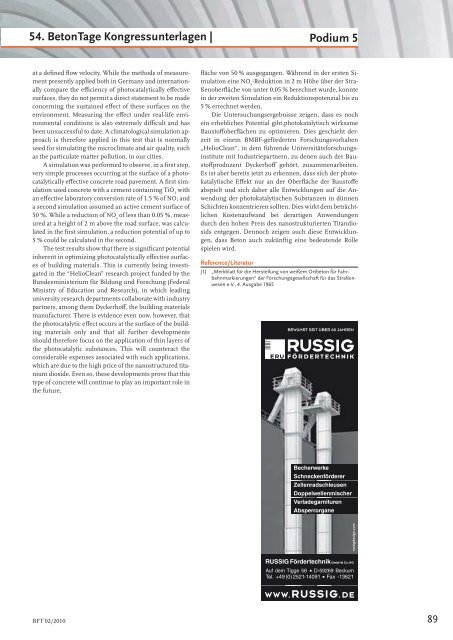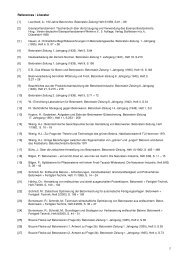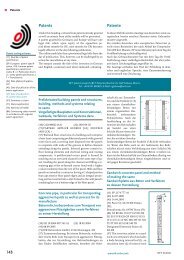Concrete Plant + Precast Technology Betonwerk ... - BFT International
Concrete Plant + Precast Technology Betonwerk ... - BFT International
Concrete Plant + Precast Technology Betonwerk ... - BFT International
Erfolgreiche ePaper selbst erstellen
Machen Sie aus Ihren PDF Publikationen ein blätterbares Flipbook mit unserer einzigartigen Google optimierten e-Paper Software.
54. BetonTage Kongressunterlagen |<br />
at a defi ned fl ow velocity. While the methods of measurement<br />
presently applied both in Germany and internationally<br />
compare the effi ciency of photocatalytically eff ective<br />
surfaces, they do not permit a direct statement to be made<br />
concerning the sustained eff ect of these surfaces on the<br />
environment. Measuring the eff ect under real-life environmental<br />
conditions is also extremely diffi cult and has<br />
been unsuccessful to date. A climatological simulation approach<br />
is therefore applied in this test that is normally<br />
used for simulating the microclimate and air quality, such<br />
as the particulate matter pollution, in our cities.<br />
A simulation was performed to observe, in a fi rst step,<br />
very simple processes occurring at the surface of a photocatalytically<br />
eff ective concrete road pavement. A fi rst simulation<br />
used concrete with a cement containing TiO 2 with<br />
an eff ective laboratory conversion rate of 1.5 % of NO, and<br />
a second simulation assumed an active cement surface of<br />
50 %. While a reduction of NO x of less than 0.05 %, measured<br />
at a height of 2 m above the road surface, was calculated<br />
in the fi rst simulation, a reduction potential of up to<br />
5 % could be calculated in the second.<br />
The test results show that there is signifi cant potential<br />
inherent in optimizing photocatalytically eff ective surfaces<br />
of building materials. This is currently being investigated<br />
in the “HelioClean” research project funded by the<br />
Bundesministerium für Bildung und Forschung (Federal<br />
Ministry of Education and Research), in which leading<br />
university research departments collaborate with industry<br />
partners, among them Dyckerhoff , the building materials<br />
manufacturer. There is evidence even now, however, that<br />
the photocatalytic eff ect occurs at the surface of the building<br />
materials only and that all further developments<br />
should therefore focus on the application of thin layers of<br />
the photocatalytic substances. This will counteract the<br />
considerable expenses associated with such applications,<br />
which are due to the high price of the nanostructured titanium<br />
dioxide. Even so, these developments prove that this<br />
type of concrete will continue to play an important role in<br />
the future.<br />
<strong>BFT</strong> 02/2010<br />
Podium 5<br />
fl äche von 50 % ausgegangen. Während in der ersten Simulation<br />
eine NO x -Reduktion in 2 m Höhe über der Straßenoberfl<br />
äche von unter 0,05 % berechnet wurde, konnte<br />
in der zweiten Simulation ein Reduktionspotenzial bis zu<br />
5 % errechnet werden.<br />
Die Untersuchungsergebnisse zeigen, dass es noch<br />
ein erhebliches Potential gibt,photokatalytisch wirksame<br />
Baustoff oberfl ächen zu optimieren. Dies geschieht derzeit<br />
in einem BMBF-geförderten Forschungsvorhaben<br />
„HelioClean“, in dem führende Universitätsforschungsinstitute<br />
mit Industriepartnern, zu denen auch der Baustoff<br />
produzent Dyckerhoff gehört, zusammenarbeiten.<br />
Es ist aber bereits jetzt zu erkennen, dass sich der photokatalytische<br />
Eff ekt nur an der Oberfl äche der Baustoff e<br />
abspielt und sich daher alle Entwicklungen auf die Anwendung<br />
der photokatalytischen Substanzen in dünnen<br />
Schichten konzentrieren sollten. Dies wirkt dem beträchtlichen<br />
Kostenaufwand bei derartigen Anwendungen<br />
durch den hohen Preis des nanostrukturierten Titandioxids<br />
entgegen. Dennoch zeigen auch diese Entwicklungen,<br />
dass Beton auch zukünftig eine bedeutende Rolle<br />
spielen wird.<br />
Reference/Literatur<br />
[1] „Merkblatt für die Herstellung von weißem Ortbeton für Fahrbahnmarkierungen“<br />
der Forschungsgesellschaft für das Straßenwesen<br />
e.V., 4. Ausgabe 1965<br />
���������������������������<br />
Becherwerke<br />
Schneckenförderer<br />
Zellenradschleusen<br />
Doppelwellenmischer<br />
Verladegarnituren<br />
Absperrorgane<br />
russigdesign.com<br />
RUSSIG Fördertechnik GmbH & Co. KG<br />
Auf dem Tigge 58 D-59269 Beckum<br />
Tel. +49 (0) 2521-14091 Fax -13621<br />
�������������<br />
89












